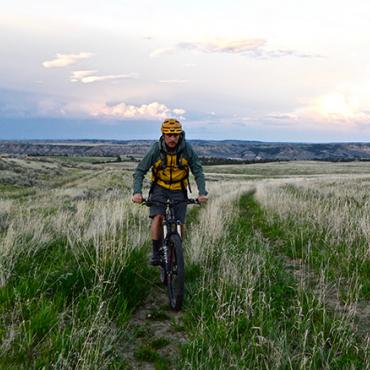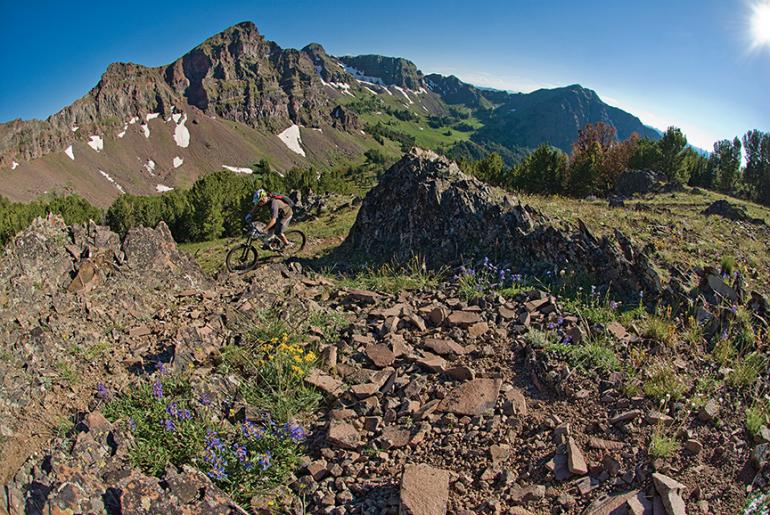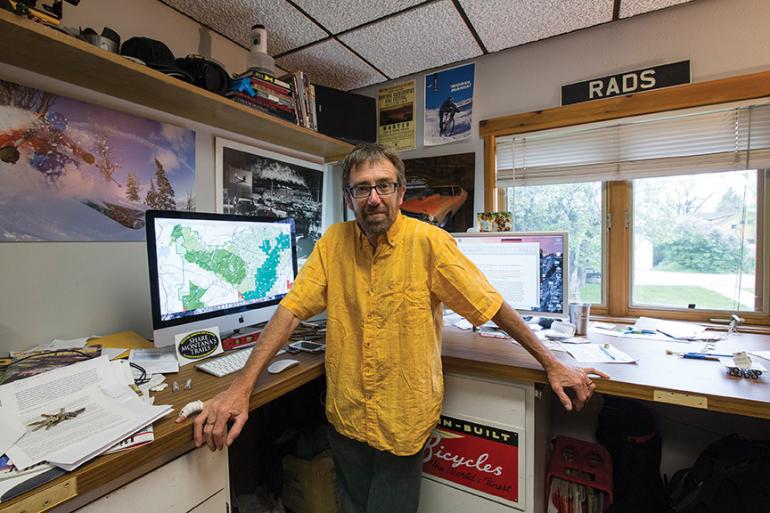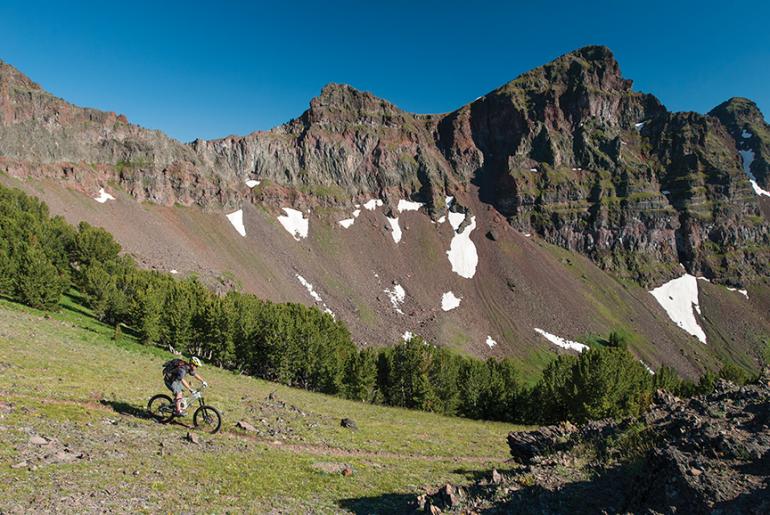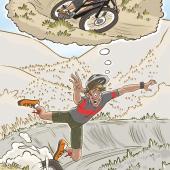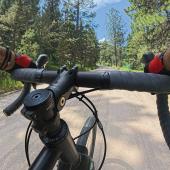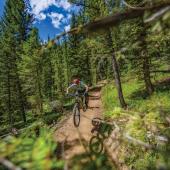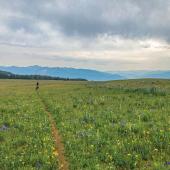The Trail Ahead
Mountain-bike advocacy in southwest Montana.
The debate over mountain biking in Wilderness Study Areas and Recommended Wilderness Areas has been a heated one for decades. With the Custer-Gallatin set to revise its Forest Plan for the first time in 30 years, the issue is once again in the front of every Bozeman mountain bikers’ mind. Recently, I sat down with renowned Bozeman photographer and mountain-bike advocate Bob Allen. As a founding member of the Montana Mountain Bike Alliance, Allen knows first-hand the issues at stake. Here’s what he had to say.
David Tucker: You got your first mountain bike in 1985. What convinced you that dirt was where you wanted to be?
Bob Allen: We grew up riding bikes all over, exploring on Stringrays south of Bozeman when there was nothing out there. South of Kagy was pretty Wild West. We had bike clubs that were cloak-and-dagger exclusive, a Mean Girls kind of thing for Montana boys in the ‘70s. The freedom that the bicycle provided was an integral part of my childhood.
DT: When did biking go from something you did with your friends to something that was going to be a major part of your life?
BA: After high school, I was in the Navy in London. I walked into a bike shop and took one for a demo. I said to myself, “Wow, I really like ridin’ bikes.” Two years later, I was stationed on a helicopter carrier in Japan. There was this chrome Nishiki in the window of a bike shop—that was ‘85. My first crash was on my way from the shop to the ship. I dropped into these steep rice terraces and went right over the bars. When I moved back to Montana for a summer in 1986, I raced road bikes and started riding singletrack on fat tires in Bozeman and Helena.
DT: How did you end up photographing mountain biking?
BA: I went to junior college in Orange County, California where I studied photography and competed in road races. Road biking led to mountain-bike connections during the 80s, when the sport was growing and interest was exploding. A BMX buddy of mine, Hans Rey, and I set up a photo session of Hans putting on a trials show on top of cars in Hwy. 405 gridlock. I moved back to England with that photo story in ’89, which launched my career. The timing was good as I became an instant expert because I was coming from southern California bike scene. But I missed Montana. I missed winters and skiing. I got back here in 1991.
DT: What was going on in Bozeman in 1991 in terms of mountain biking?
BA: It certainly wasn’t very organized—there wasn’t a need to be as all the tails were open and shared. One of the guys I grew up with here in Bozeman, he and I had done one of the first big bike rides up Hyalite Peak—that was actually the summer of 1986, and I was on that bike I bought in Japan. In the ‘90s, the guys I grew up with riding around town had that mountain-biker mentality. We were using bikes to broaden our exploration. I met my future wife, Estela, and we used bikes to explore the local mountains. Grassy Mountain before it was really Grassy Mountain. Ross Pass, some of the stuff north of Bridger Bowl, and upper Hyalite and the Northern Gallatin Range.
DT: When did user conflict and access become an issue, and when did you get involved?
BA: The challenge came from a growing population and an outdoor constituency like Bozeman. The bike companies are like drug cartels, the shops are the distributors, and we’re [outdoor-sports media] the dealers. “You need this new bike. Isn’t it cool?” We create an image that puts people onto a given landscape with a given carrying capacity. Once that capacity is exceeded, you get conflict. Out of the 2005 Travel Plan, a time-share system was created on some of Bozeman’s more popular trails. We were involved with that. It was an early effort to manage the finite recreational resources before conflict ensued. Then “The Lawsuit” came, in which the conservation groups sued the Forest Service to keep bikes out of Wilderness Study Areas, such as the Hyalite-Porcupine area. That put more people on fewer trails. Now, the Custer-Gallatin is going through a Forest Plan Revision for the first time in 30 years. Time-sharing, which came out of the 2005 Travel Plan, is an important tool and we as the bike community need to make sure it works. It’s a solution we can bring to the negotiating table. It’s a way of showing some selflessness—which is a lesson that all trail users can learn from. With this Forest Plan Revision, riders need to step up to help shape the future of recreation in our area.
DT: What is the status of the relationship between the bike community and the conservation community?
BA: First of all, bikers are conservationists. We want to see pristine public lands and bicycle access permanently protected. Since 2007, we’ve come to the table in good faith and presented a pretty middle-of-the-road solution, whatever the landscape may be. It may not be middle-of-the-road to the people that want Wilderness or nothing, but we’re talking landscapes that we’ve ridden bikes on for over 30 years without any issues. And the mountain-bike community continues to lose trails valued for their lower-case “w” wilderness values. Wanting continued access to these trails doesn’t make us anti-Wilderness outright. Which begs the question: what and who are conservation groups protecting these areas from—from quiet, low-impact bicyclists? There are certainly examples of lip service from conservation groups in terms of collaborating with the bike community, and then there are the hard facts that are counter to those statements. That’s part of why we’re weary of investing time as volunteers against paid staff. It’s an interesting dynamic, because it’s survival of the fittest, and comes down to who can stay and have a voice until the end.
Locally, I think there’s a much better understanding now than after the “food fight” that started after “The Lawsuit.” The conservation staffers answer to a board or their thousands of members who have a preconceived outcome for the landscape. For that reason, negotiations can be slow and frustrating. It’s the nature of the Wilderness Machine.
DT: Where are we headed, in relation to trails in WSAs and RWAs and biking?
BA: The recent ban on mountain bikes in the Boulder-White Clouds in Idaho was a wakeup call to the bike community. We have the numbers; we just need to overcome the apathy. The good news is that Montana’s mountain-bike community is organized to a new level that will change the dialog. In the future, when the conservation community wants to revive stalled Wilderness bills, like Tester’s bill concerning the Beaverhead-Deerlodge, or new proposals for the Gallatins, the Bitterroot, or the Blackfoot, the trails that are closed now to bicycles will be back on the negotiating table. Then the bike community will have the momentum to give support to the bill to actually pass Wilderness. Without revisiting those trails, I foresee that Wilderness bills will be more difficult to pass.
The mountain-bike community has continued to be closed out of trails we’ve ridden and cared for and valued for their lower-case “w” wilderness values. We’ve proven ourselves everywhere to be some of the best trail advocates out there, and the Forest Service needs all the help it can get. We all want to keep that relationship going. The bike community will be pivotal for the passage of future Wilderness.
DT: Are there creative solutions out there that are being overlooked? Outside of the federal agencies, is there local or private money to get projects done?
BA: Bridger Bowl, for one. The new summer shared-use recreation trails up at Big Sky are game-changers, which Bozeman should eye for Bridger and Bohart Ranch. And the potential bike park at the landfill north of town has great promise. Between those opportunities, we could avoid a lot of National Forest red tape and politics. Obama signed a Ski Area Act in 2011 and the money is there for summer recreation on public lands-leased ski areas; so the Bridger area offers the path of least resistance for new trail planning and development. The dump bike park would catch another segment because you could ride to it from town. Those areas would entertain people on bicycles and give the bike community something to coalesce around.
DT: How can mountain bikers do a better job improving their image and being stewards of the land?
BA: There’s a huge opportunity, and more importantly, a responsibility to be part of the solution and not part of the problem. Volunteer, do trail work, and help care for the resource; good behavior and peer-pressure policing of what’s acceptable. We’re environmentally challenged around Bozeman in that the valley dries out and yet all our trails stay wet until well into June. There’s this huge pent up demand to go ride and we end up doing a lot of damage to trail systems that are ridden too early. Part of the cycling ethos that needs to be developed around here is raising the level of awareness. We all need to be the good example—Sypes on a weekday night is not the time to go do your Strava hot laps.
DT: We’ve talked a lot about trails. What’s your favorite backcountry ride?
BA: Anything built by Terry Johnson—but specifically, Mile Creek along the CDT. It had flow 20 years before the term was cool and gets you into a big wild place. It’s a big ride up to 10,000 feet with 53 switchbacks. There will always be the Strava/gymnasium mentality, but one of the things about riding bikes in big backcountry settings is that that’s not really the appeal to that sort of day out, and that the wilderness ethic (small “w”) is absolutely present—that’s why we’re there, and that’s why we belong there.
DT: Lastly, we’ve talked about responsibility and stewardship, but your reputation as a troublemaker precedes you. Give us one story about some tomfoolery you’re particularly proud of.
BA: (Long pause. Chuckles. Under his breath: 1978… ‘79. What’s the statute of limitations…?) In the era of Animal House there was a Bozeman High homecoming parade that was dismembered in the spirit of John Belushi. I think the school set a state record for suspensions. The city of Bozeman was pretty horrified. I’ll leave it at that.
To find out more about mountain-bike advocacy, visit montanamountainbikealliance.com.

